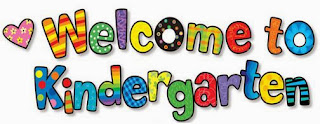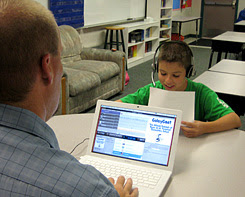A Collaborative Assignment
Project Based Learning: Parts 1 and 2
By: Rachel Hinton, Elizabeth Johnson, Calah Reynolds
Anthony Capps is a 3rd grade teacher in Baldwin County. We really enjoyed his videos,
Project Based Learning Part 1 and
Project Based Learning Part 2. He really brought to light just how effective PBL can be in the classroom. It is really great to actually have someone give their different experiences with PBL and how they used it. He gave great examples of how he used it in his classroom. Through PBL, Anthony gave his students the chance to become involved in their state, community, and even half way around the world. Another things Anthony really stressed about PBL is the importance of self evaluations. A major thing we learned from these conversations is that if Project Based Learning can become the basis of learning in every classroom, then we will have a group of students that care about what is going on around them and are passionate about learning new things.
iCurio and Discovery Ed
By: Rachel Hinton, Elizabeth Johnson, Calah Reynolds
Anthony uses iCurio frequently in his classroom and let’s his students use it on their own so they can have the freedom to use the computer and search the web while still being limited to what they can see. He lets his students use iCurio like a search engine so they can save content that they find valuable in their storage. iCurio teaches virtual organization and allows students to start getting organized online at a young age. They can store websites and online materials in their storage and go through to organize and delete as they please. In addition, Anthony talks about the importance of another tool called Discovery Ed. He talks about how it is great to have visualization to couple with learning to support whatever text you’re learning about. It can be used to research further into what they are studying. It gives videos to gather more information about a topic. Students can use it for research, but Anthony also uses it to teach with as a teacher. Students tend to learn more when they can see and hear the information. So, Discovery Ed is an awesome tool for both students and teachers to use.

By: Calah Reynolds
According to Anthony Capps in
Additional Thought About Lessons, lessons are at least four layers thick. The first layer is how the lesson fits in with your year. You should make sure your curriculum fits in with all the standards. The next layer would be the unit. You have to make sure your unit flows together and that everything is connected somehow. You can’t just give the students the work all at once, you have to give it to them in units and at the end of each unit they should be able to master what you have gone over. Next is the week and during the weekly schedule you need to make sure you can get everything done that you have planned. Last is the daily lesson. This is how you deliver it to your students. You should have something to keep their attention, something to keep them engaged, and something after the lesson to cover what you taught and make sure they understand it so you know where to pick up the next day. I think that those four components are really important to remember when making lesson plans. I also think it’s important to remember not to fall behind with your lessons because if you do it might mess up your whole unit and maybe even year.
The Anthony-Strange List For Teachers Part 1
By: Elizabeth Johnson
I really enjoyed this video,
”The Anthony-Strange List for Teachers Part 1” ! I learned so many helpful tips that I will be able to use not only now, but also as a future teacher. There were six tips that were discussed in this video.
1) Be a constant learner yourself. It is so important to be interested in learning yourself as a teacher. If you are not a learner, then you won’t be a successful teacher. You have to model learning for your students, and if you cannot do that, then how will your students ever be able to learn from you?
2) Teaching never ends. It is hard work, but it is rewarding. As a teacher, it is important to know that work is not separate from play. You can learn the craft of teaching in your free time. Yes, read books for entertainment. However, substitute them for research books to help you become a better teacher. Allow your work and love for teaching to come up in conversations. You cannot limit your work hours to an eight hour day. You will never be as effective as you can be. Allow work to be fun. The effort is rewarding.
3) Be flexible. The unexpected will happen. You never know when surprises will happen when you are a teacher. It is important to be creative and flexible. I loved the example in the video where the servers were down, so the students were painting on the floor. This is a prime example to always have a back-up plan. You cannot always plan for these things, but you can have a good attitude about it and be flexible.
4) Start with a goal. If you do not have a goal or expectation to reach, it is a sure thing that you probably won’t make it there. Start with the end in mind. Think of the expectations and results you want to accomplish. What do you want your children to learn or get from the lesson? You may not get there the way you planned, but you can still get there another way.
5) Engage 100% of your students, 100% of the time, in 100% of projects. It is important to make sure that what you are teaching is shareable. Is what I am teaching or how I am teaching motivating my students to learn? One question you can ask yourself is, “How can I get all of my students on board today?” This will change your entire outlook on teaching.
6) Reflect, revise, and share your work with an audience. Even as a teacher, we must constantly be reflecting on and revising our work and teaching strategies. Take critiques you get from your audience or students to revise your work and make it better. Students change, technology changes, curriculum changes, so it is important to constantly be reflecting and revising our work in order to be the most effective teacher we can be.
Use Technology- Don’t Teach It!
By: Rachel Hinton
![”Technology]()
In Anthony Capps and Dr. Strange’s conversation on technology in the classroom, Anthony gives some really great advice on how teachers should allow the students to actually use technology in order for them to learn it, not teach it to them. Anthony tells how if you allow students to experience the technology for themselves, without teaching it to them, they are more likely to take away from their mistakes and know what to do next time. He allows the students to experience different types of technology everyday so they can become familiar with different things that will help them in future projects.
He also makes a really great point that many times the student may actually know how to use the technology better than you. With this being said, there may come a time when the student has a question that you cannot answer, this is okay, together you can find out. We can use our students to help us learn every day and technology is a great way to allow them to do that.



















.jpg)










